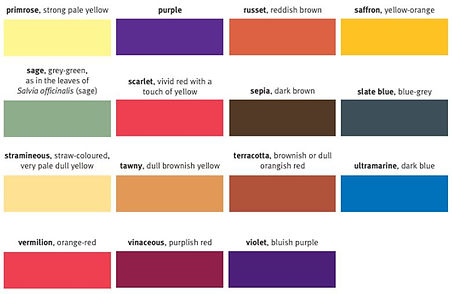Alpines are plants comprising of bulbs, shrubs & herbaceous perennials that come from mountainous regions above the tree line, they can often cope with some drought.
Anther is the part of the stamen containing the pollen. Each anther is usually divided into 2 lobes , each lob contains one or more pollen sacs. The stamen is the male reproductive part of the plant, I find it easiest to remember this as it has the word 'men' in 'stamen'.
Anthocyanins are the water soluble pigments in plant cells responsible for red, blue & purple colours, the actual colour is determined by the pH in the environment (red in acidic conditions or blue in alkaline conditions). They help attract pollinators. They act as a sunscreen protector. They can reduce stress & cell damage from external factors like drought, UV radiation & heavy metals.
Bract(s) are modified leaves; they usually have a flower or clusters of flowers growing at the leaf stalk that the bract surrounds. Bracts can be small or large. They can be bigger and brighter than the true flowers of a plant, such as in the Arum Lily or Poinsettia.
Calyx (pl. Calyces) is often a cup like structure, it is the outermost whorl of floral organs, it forms a protective layer around the flower before it opens, it is often divided into sepals.
Cotyledons are the first 2 leaves that are formed when a seed germinates, they will not resemble the leaves of the plant. The first true leaves appear after these leaves - these will look like the leaves of the plant, you prick out the seedling holding these leaves rather than holding & risking damaging the stem.
Deciduous plants lose their leaves during a particular season (usually winter).
Dioecious plants have male and female flowers on different plants: male plants & female plants, e.g. my Datisca cannabina (False Hemp)
Herbaceous plants do not have a woody structure like a shrub or a tree.
Perennial essentially means that the plant is expected to live for more than two years: there are evergreen perennials and deciduous perennials.
Racemes
Spadix (pl. Spadices) a spadix is a spike which is often thick and fleshy that has tiny flowers clustered on it. you may not easily see the tiny flowers unless you take a photograph and blow it up, or use macro photography or some other magnifier. [Extra Fun Fact* In some plants the spadix actually produces heat through a process called thermogenesis; , this is particularly in the male pollen producing flowers; this is most probably to attract pollinators such as carrion beetles and flies as the heat helps to volatize the foul smells they find attractive and it is also a warmer more welcoming environment for them in cooler weathers. The Titan Arum (Amorphophallus titanum) is an example of a plant that does this.]
Spathe(s) these look like a large flower petal but they are actually a bract, a spathe is a single bract that surrounds a spadix; their job is to attract pollinators to the flower; the spathes often do this by being vibrant colours - the actual flowers are usually small flowers covering a large spike called a spadix (like on an Arum Lily).
Stigma this is the female reproductive part of a flower, pollen from an anther of a flower is transferred onto the sticky stigma by wind pollination, or by pollinators such as insects, as well as other pollination methods; this will fertilise the flower, this will allow fruits or seeds to be produced by the plant.
COLOUR TERMS
Colours are difficult to describe as there are so many shades.
The following chart is taken from The Kew Plant Glossary, An
Illustrated Dictionary Of Plant Terms by Henk Beentje,
illustrations by Juliet Williamson (2010)


